Queer anarchism
| Part of a series on |
| Anarchism |
|---|
 |
|
Queer anarchism, or anarcha-queer, is an anarchist school of thought that advocates anarchism and social revolution as a means of queer liberation and abolition of hierarchies such as homophobia, lesbophobia, transmisogyny, biphobia, transphobia, heteronormativity, patriarchy, and the gender binary. People who campaigned for LGBT rights both outside and inside the anarchist and LGBT movements include John Henry Mackay,[1] Adolf Brand and Daniel Guérin.[2] Individualist anarchist Adolf Brand published Der Eigene from 1896 to 1932 in Berlin, the first sustained journal dedicated to gay issues.[3][4]
History[]
Early history[]
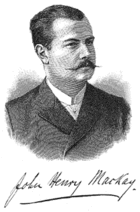
Anarchism's foregrounding of individual freedoms made for a natural defense of homosexuality in the eyes of many, both inside and outside of the anarchist movement. In Das Kuriositäten-Kabinett (1923), Emil Szittya wrote about homosexuality that "very many anarchists have this tendency. Thus I found in Paris a Hungarian anarchist, Alexander Sommi, who founded a homosexual anarchist group on the basis of this idea". His view is confirmed by Magnus Hirschfeld in his 1914 book Die Homosexualität des Mannes und des Weibes: "In the ranks of a relatively small party, the anarchist, it seemed to me as if proportionately more homosexuals and effeminates are found than in others".[5] Italian anarchist Luigi Bertoni (who Szittya also believed to be homosexual) observed: "Anarchists demand freedom in everything, thus also in sexuality. Homosexuality leads to a healthy sense of egoism, for which every anarchist should strive".
In Oscar Wilde's The Soul of Man under Socialism, he passionately advocates for an egalitarian society where wealth is shared by all while warning of the dangers of authoritarian socialism that would crush individuality.[6] He later commented: "I think I am rather more than a Socialist. I am something of an Anarchist, I believe".[7] In August 1894, Wilde wrote to his lover Lord Alfred Douglas to tell of "a dangerous adventure". He had gone out sailing with two lovely boys—Stephen and Alphonso—and they were caught in a storm. "We took five hours in an awful gale to come back! [And we] did not reach pier till eleven o’clock at night, pitch dark all the way, and a fearful sea. [...] All the fishermen were waiting for us". Tired, cold and "wet to the skin", the three men immediately "flew to the hotel for hot brandy and water", but there was a problem as the law stood in the way: "As it was past ten o’clock on a Sunday night the proprietor could not sell us any brandy or spirits of any kind! So he had to give it to us. The result was not displeasing, but what laws!". Wilde finishes the story: "Both Alphonso and Stephen are now anarchists, I need hardly say".[6]
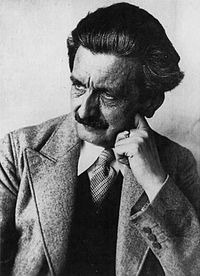
Anarcho-syndicalist writer Ulrich Linse wrote about "a sharply outlined figure of the Berlin individualist anarchist cultural scene around 1900", the "precocious Johannes Holzmann" (known as Senna Hoy): "an adherent of free love, [Hoy] celebrated homosexuality as a 'champion of culture' and engaged in the struggle against Paragraph 175".[8] The young Hoy (born 1882) published these views in his weekly magazine Kampf (Struggle) from 1904, which reached a circulation of 10,000 the following year. He decided to devote himself entirely to writing and political activism from an anarchist standpoint. In 1904, he published a booklet entitled "Das dritte Geschlecht" ("The Third Gender"). In it, he attacked homophobia, laying most of the blame on religion. Above all, the text was intended to be educational and covered evolution, biology and issues then facing homosexuals. From 1904 to 1905, Holzmann edited the journal Der Kampf: Zeitschrift für gesunden Menschenverstand (The Struggle: Journal for Common Sense). Though it was not published by any particular organization, the journal was anarchist in outlook. In addition to fictional stories, Der Kampf published articles on various topics, including many about homosexuality. Among its writers were Else Lasker-Schüler, , and Erich Mühsam and, at its best, it had a circulation of up to 10,000. During this time, Holzmann wrote an article entitled "Die Homosexualität als Kulturbewegung" ("Homosexuality as a Cultural Movement"). He argued that the right to privacy entailed that "no one has the right to intrude in the private matters of another, to meddle in another's personal views and orientations, and that ultimately it is no one's business what two freely consenting adults do in their homes." He attacked Paragraph 175 of the German criminal code which criminalized homosexual acts.[9]
German anarchist psychotherapist Otto Gross also wrote extensively about same-sex sexuality in both men and women and argued against its discrimination.[10] Heterosexual anarchist (1849–1898) spoke positively of homosexuality from the beginning of the 1890s in his German-language journal Der arme Teufel (Detroit).
John Henry Mackay was an individualist anarchist known in the anarchist movement as an important early follower and propagandizer of the philosophy of Max Stirner.[11] Alongside this, Mackay was also an early signer of Magnus Hirschfeld's "Petition to the Legislative Bodies of the German Empire" for "a revision of the anti-homosexual paragraph 175 (his name appeared in the first list published in 1899)".[12][13] He also kept a special interest about Oscar Wilde and was outraged at his imprisonment for homosexual activity.[12] Nevertheless, Mackay entered into conflict with Hirschfeld and his organization the Scientific Humanitarian Committee.[14]
The individualist anarchist Adolf Brand was originally a member of Hirschfeld's Scientific Humanitarian Committee, but formed a break-away group. Brand and his colleagues, known as the Gemeinschaft der Eigenen ("Community of Self-owners"), were also heavily influenced by the writings of Stirner.[4]
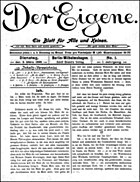
They were opposed to Hirschfeld's medical characterization of homosexuality as the domain of an "intermediate sex".[15] Ewald Tschek, another homosexual anarchist writer of the era, regularly contributed to Adolf Brand's journal Der Eigene and wrote in 1925 that Hirschfeld's Scientific Humanitarian Committee was a danger to the German people, caricaturing Hirschfeld as "Dr. Feldhirsch". Although Mackay was closer in views to Brand and his "Community of Self-owners" in some respects as compared to Hirschfeld's Scientific Humanitarian Committee, nevertheless he did not agree with Brand's antifeminism and almost misogynistic views believing his "anarchist principle of equal freedom to all certainly applied to women as well as men".[16]
Der Eigene was the first gay journal in the world, published from 1896 to 1932 by Brand in Berlin. Brand contributed many poems and articles himself. Other contributors included Benedict Friedlaender, Hanns Heinz Ewers, Erich Mühsam, Kurt Hiller, Ernst Burchard, John Henry Mackay, Theodor Lessing, Klaus Mann and Thomas Mann as well as artists Wilhelm von Gloeden, Fidus and Sascha Schneider. After the rise to power by the Nazis, Brand became a victim of persecution and had his journal closed.
The Ukrainian anarchist military leader Nestor Makhno was known to employ disguises as part of his guerilla tactics. His most commonly assumed disguise involved putting on makeup and dressing as a woman, so that he could survey enemy positions without detection.[17][18]

The prominent American anarchist Emma Goldman was also an outspoken critic of prejudice against homosexuals. Her belief that social liberation should extend to gay men and lesbians was virtually unheard of at the time, even among anarchists.[19] As Magnus Hirschfeld wrote, "she was the first and only woman, indeed the first and only American, to take up the defense of homosexual love before the general public".[20] In numerous speeches and letters, she defended the right of gay men and lesbians to love as they pleased and condemned the fear and stigma associated with homosexuality. As Goldman wrote in a letter to Hirschfeld: "It is a tragedy, I feel, that people of a different sexual type are caught in a world which shows so little understanding for homosexuals and is so crassly indifferent to the various gradations and variations of gender and their great significance in life".[20]
Despite these supportive stances, the anarchist movement of the time certainly was not free of homophobia and an editorial in an influential Spanish anarchist journal from 1935 argued that an anarchist should not even associate with homosexuals, let alone be one: "If you are an anarchist, that means that you are more morally upright and physically strong than the average man. And he who likes inverts is no real man, and is therefore no real anarchist".[21]

Lucía Sánchez Saornil was a main founder of the Spanish anarcha-feminist federation Mujeres Libres who was open about being a lesbian.[22] At a young age, she began writing poetry and associated herself with the emerging Ultraist literary movement. By 1919, she had been published in a variety of journals, including Los Quijotes, Tableros, Plural, Manantial and La Gaceta Literaria. Working under a male pen name, she was able to explore lesbian themes[23] at a time when homosexuality was criminalized and subject to censorship and punishment. Dissatisfied with the chauvinistic prejudices of fellow Republicans, Lucía Sánchez Saornil joined with two compañeras, Mercedes Comaposada and Amparo Poch y Gascón, to form Mujeres Libres in 1936. Mujeres Libres was an autonomous anarchist organization for women committed to a "double struggle" of women's liberation and social revolution. Lucía and other "Free Women" rejected the dominant view that gender equality would emerge naturally from a classless society. As the Spanish Civil War exploded, Mujeres Libres quickly grew to 30,000 members, organizing women's social spaces, schools, newspapers and daycare programs.

The writings of the French bisexual anarchist Daniel Guérin offer an insight into the tension sexual minorities among the left have often felt. He was a leading figure in the French left from the 1930s until his death in 1988. After coming out in 1965, he spoke about the extreme hostility toward homosexuality that permeated the left throughout much of the 20th century.[24] "Not so many years ago, to declare oneself a revolutionary and to confess to being homosexual were incompatible", Guérin wrote in 1975.[25]
In 1954, Guérin was widely attacked for his study of the Kinsey Reports in which he also detailed the oppression of homosexuals in France: "The harshest [criticisms] came from Marxists, who tend seriously to underestimate the form of oppression which is antisexual terrorism. I expected it, of course, and I knew that in publishing my book I was running the risk of being attacked by those to whom I feel closest on a political level".[26] After coming out publicly in 1965, Guérin was abandoned by the left and his papers on sexual liberation were censored or refused publication in left-wing journals.[27] From the 1950s.
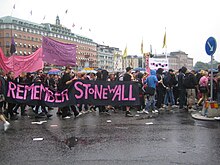
Guérin moved away from Marxism–Leninism and toward a synthesis of anarchism and Marxism close to platformism, which allowed for individualism while rejecting capitalism, who would eventually embrace anarcho-communism. Guérin was involved in the uprising of May 1968 and was a part of the French gay liberation movement that emerged after the events. Decades later, Frédéric Martel described Guérin as the "grandfather of the French homosexual movement".[28]
In the United States, the influential anarchist thinker Paul Goodman came out late in his career as bisexual. The freedom with which he revealed in print and in public his romantic and sexual relations with men (notably in a late essay, "Being Queer"),[29] proved to be one of the many important cultural springboards for the emerging gay liberation movement of the early 1970s.
Contemporary history[]
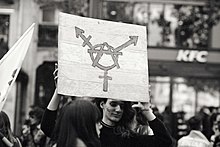
The early gay liberation movement shared many theoretical foundations and philosophies with anarchist movements in the mid twentieth century.[30] Chants such as "2-4-6-8, smash the church, smash the state!" were popular around the time of the Stonewall riots, setting the tone for a queer rights movement grounded in anarchist thought.[30] The two campaigns both focus on rejecting normative thinking and the state in favor of personal liberty and pleasure.[30]
Anarchism and Queer theory both reject paternalistic state structures that depend on capitalism and the nuclear family.[31] Instead, both favor forms of self-determination and the reordering of society.[32] An example of anarchism and queerness intersecting can be found in those who engage in non-monogamous relationships, these are inherently anarchical, as they are rejecting traditional power structures that shape the nuclear family. This concept has been coined Relationship Anarchism.[33]
Anarcha-queer originated during the second half 20th century among anarchists involved in the gay liberation movement, who viewed anarchism as the road to harmony between heterosexual/cis people and LGBT people. Anarcha-queer has its roots deep in queercore, a form of punk rock that portrays homosexuality in a positive manner. Like most forms of punk rock, queercore attracts a large anarchist crowd. Anarchists are prominent in queercore zines. There are two main anarchy-queer groups: , a British group with branches in most major cities; and Bash Back!, an American network of queer anarchists. Queer Fist appeared in New York City and identifies itself as "an anti-assimilationist, anti-capitalist, anti-authoritarian street action group, came together to provide direct action and a radical queer and trans-identified voice at the Republican National Convention (RNC) protests".[34]

Anarcha-feminist collectives such as the Spanish squat Eskalera Karakola and the Bolivian Mujeres Creando give high importance to lesbian and bisexual female issues working on the principles of autogestion and organizes activities based on direct action. The Fag Army is a left-wing queer anarchist group in Sweden, which launched its first action on August 18, 2014, when it pied the Minister for Health and Social Affairs, Christian Democrat leader Göran Hägglund.[35]
Activism[]

Queer anarchists have been active in protesting and activism, using direct action against what is seen as homonormative consumerism and pink capitalism. Queer anarchists have set up squats and autonomous zones as well as urban communities for the queer and LGBT community. Rural communities often rely on social media to grow anarchist movements and networks, due to these communities being geographically isolated from urban centers.[36] Social networking sites facilitate knowledge transmission that provides alternative ideals to people in rural populations that were previously only available to urban dwellers.[36]
Many queer anarchists embrace the notion of radical individualism, influenced by individual philosophers like Max Stirner. Organizations like ACT-Up a punk anti-racist, anti-fascist organization and supported and composed of queer anarchists organization that has supported queer radicals and direct action.[37] Later during the WTO protests queer anarchists played a vital role in organizing the mass protests, the protests would lead to the explosion of the anti-globalization movement.[38]
In popular culture[]

"Be gay, do crimes" is a slogan popular in contemporary Pride parades, LGBT-related protests, and graffiti. In 2018, it was popularised on Twitter by a meme created by Io Ascarium of the ABO Comix collective, which sells comics made by other abled LGBTQ+ prisoners.[39] Ascarium describes the phrase as coming "from the communal grab-bag of anti-assimilationist queer slogans. Like 'ACAB' or 'Stonewall was a Riot' it was pulled from the chaotic ether, originated nowhere and belongs to nobody," though Google Trends suggests interest has existed since at least 2011.[40][41] The “memeification” of the “be gay do crime” slogan is an example of increased accessibility into anarchist schools of thought.[42]
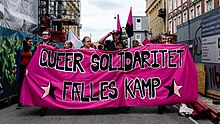
The slogan "Be gay, do crime" is an anti-capitalistic and anti-authoritarian statement, implying that crime and incivility may be necessary to earn equal rights given the criminalization of homosexuality around the world and that the Stonewall uprising was a riot. Within the anarchist space, the Mary Nardini Gang reflected on their manifesto Toward the Queerest Insurrection with a book entitled Be Gay Do Crime[43] in which they affirm "the reality and the continuity of a culture and a history of experiencing outlawness, illegality, and lack of citizenship."[44] Mark Bieschke, a curator at the GLBT History Museum, claimed that the slogan is meant to stand against the "polished, corporate narrative of Pride".[45][46]

In November 2019, American cartooning publication The Nib compiled an anthology of short comics "featuring queer history, memoir, and satire" entitled Be Gay, Do Comics, launching on the crowdfunding platform Kickstarter[47] and later published for mainstream distribution in September 2020.[48] In the book's foreword, Nib co-editor Matt Lubchansky explained the title as an homage to Ascarium's meme, interpreting it as a reminder that “Queerness has always been transgressive, regardless of its legal status.”[49]
See also[]
- Anarchism and issues related to love and sex
- Communism and homosexuality
- DUMBA – a New York collective living space with Anarcha-queer tendencies
- Gay Shame – a movement self-described as a radical alternative to gay mainstreaming
- Pink capitalism
- Queeruption – a queercore festival where anarchists are prominent
- Socialism and LGBT rights
References[]
- ^ "The story of one person's struggle against intolerance and repression during the early 20th century homosexual emancipation movement in Germany. Mackay is a very interesting figure in both anarchist and homosexual circles."Hubert Kennedy. Anarchist Of Love: The Secret Life Of John Henry Mackay. Archived March 22, 2012, at the Wayback Machine
- ^ "Although by 1968 he could be seen as the “grandfather of the French homosexual movement” , Daniel Guérin has always been better known outside gay circles for his rôle in the revolutionary movement. On the revolutionary left of the Socialist Party in the 1930s, he was later heavily influenced by Trotsky, before becoming attracted to the libertarian communist wing of the anarchist movement." David Berry. "For a dialectic of homosexuality and revolution"
- ^ Karl Heinrich Ulrichs had begun a journal called Uranus in 1870, but only one issue ("Prometheus") was published. (Kennedy, Hubert, Karl Heinrich Ulrichs: First Theorist of Homosexuality, In: 'Science and Homosexualities', ed. Vernon Rosario (pp. 26–45). New York: Routledge, 1997.
- ^ Jump up to: a b Kennedy, Hubert (1983-01-01). Anarchist of Love: The Secret Life of John Henry Mackay p.7 (First ed.). Mackay Society.
- ^ Hirschfeld, Magnus, 1914. Die Homosexualität des Mannes und des Weibes (Berlin: Louis Marcus)
- ^ Jump up to: a b Kristian Williams. "The Soul of Man Under... Anarchism?"
- ^ According to his biographer Neil McKenna, Wilde was part of a secret organization that aimed to legalize homosexuality, and was known among the group as a leader of "the Cause". (McKenna, Neil. 2003. The Secret Life of Oscar Wilde.)
- ^ Linse, Ulrich, Individualanarchisten, Syndikalisten, Bohémiens, in "Berlin um 1900", ed. Gelsine Asmus (Berlin: Berlinische Galerie, 1984)
- ^ Fähnders, Walter (1995-11-27). "Anarchism and Homosexuality in Wilhelmine Germany". Journal of Homosexuality. 29 (2–3): 117–154. doi:10.1300/J082v29n02_05. ISSN 0091-8369. PMID 8666752. Retrieved 2020-12-12.
- ^ Gottfried Heuer. "Otto Gross (1877–1920) – Biographical Survey".
- ^ "IDEAS OF MAX STIRNER.; First English Translation of His Book, "The Ego and His Own" – His Attack on Socialism – The Most Revolutionary Book Ever Published." by JAMES HUNEKER
- ^ Jump up to: a b Kennedy, Hubert (1983-01-01). Anarchist of Love: The Secret Life of John Henry Mackay p.12 (First ed.). Mackay Society.
- ^ Hubert Kennedy. Anarchist Of Love: The Secret Life Of John Henry Mackay.pg. 12
- ^ Kennedy, Hubert (1983-01-01). Anarchist of Love: The Secret Life of John Henry Mackay, p.8 (First ed.). Mackay Society.
- ^ New York: Howard Fertig, 1985.
- ^ Kennedy, Hubert (1983-01-01). Anarchist of Love: The Secret Life of John Henry Mackay p.35 (First ed.). Mackay Society.
- ^ Nikolaev, Alexej (1947). First among Equals (in Russian). Moscow. p. 124. ASIN B0719CM1ZT.
- ^ Skirda, Alexandre (2004). "28: Nestor Makhno's Personality: Character Traits and Idiosyncrasies". Nestor Makhno: Anarchy's Coassack. Translated by Paul Sharkey. Edinburgh: AK Press. p. 296. ISBN 1-902593-68-5.
- ^ Katz, Jonathan Ned (1992). Gay American History: Lesbians and Gay Men in the U.S.A. New York City: Penguin Books. pp. 376–380.
- ^ Jump up to: a b Goldman, Emma (1923). "Offener Brief an den Herausgeber der Jahrbücher über Louise Michel" with a preface by Magnus Hirschfeld. Jahrbuch für sexuelle Zwischenstufen 23: 70. Translated from German by James Steakley. Goldman's original letter in English is not known to be extant.
- ^ Quoted in Cleminson, Richard. 1995. Male inverts and homosexuals: Sex discourse in the Anarchist Revista Blanca, Published in Gert Hekma et al. (eds.)"Gay men and the sexual history of the political left" by Harrington Park Press 1995, ISBN 978-1-56023-067-0.
- ^ "basta pensar en el lesbianismo de Lucía Sánchez Saornil" Archived 2 April 2012 at the Wayback Machine
- ^ "R. Fue una época transgresora, emergió el feminismo y la libertad sexual estuvo en el candelero. Hay rastreos de muchas lesbianas escritoras: Carmen Conde[primera académica de número], Victorina Durán, Margarita Xirgu, Ana María Sagi, la periodista Irene Polo, Lucía Sánchez Saornil, fundadora de Mujeres Libres[sección feminista de CNT]... Incluso existía un círculo sáfico en Madrid como lugar de encuentro y tertulia.P. ¿Se declaraban lesbianas?R. Había quien no se escondía mucho, como Polo o Durán, pero lesbiana era un insulto, algo innombrable. Excepto los poemas homosexuales de Sánchez Saornil, sus textos no eran explícitos para poder publicarlos, así que hay que reinterpretarlos.""Tener referentes serios de lesbianas elimina estereotipos" by Juan Fernandez at El Pais
- ^ *The Parti Communiste Français was "hysterically intransigent as far as ’moral behaviour’ was concerned" (Aragon, victime et profiteur du tabou, in Gai Pied Hebdo, 4 June 1983, reproduced in Homosexualité et Révolution, pp. 62–3, quote p. 63.);
* The trotskyist Pierre Lambert's OCI was "completely hysterical with regard to homosexuality"; Lutte ouvrière was theoretically opposed to homosexuality; as was the Ligue communiste, despite their belatedly paying lip service to gay lib. (à confesse, Interview with Gérard Ponthieu in Sexpol no. 1 (20 January 1975), pp.10–14.)
* Together, Guérin argued, such groups bore a great deal of responsibility for fostering homophobic attitudes among the working class as late as the 1970s. Their attitude was "the most blinkered, the most reactionary, the most antiscientific". (Etre homosexuel et révolutionnaire, La Quinzaine littéraire, no. 215, no. spécial : ‘Les homosexualités’ (August 1975), pp. 9–10. Quote p. 10) - ^ Guérin, Daniel. 1975. Etre homosexuel et révolutionnaire, La Quinzaine littéraire, no. 215, no. spécial : ‘Les homosexualités’ (August 1975), pp. 9–10.
- ^ Letter of 27 May 1955, Fonds Guérin, BDIC, F° Δ 721/carton 12/4, quoted in Chaperon, ‘Le fonds Daniel Guérin et l’histoire de la sexualité’ in Journal de la BDIC, no.5 (June 2002), p.10
- ^ Berry, David. 2003. For a dialectic of homosexuality and revolution. Paper for "Conference on "Socialism and Sexuality. Past and present of radical sexual politics", Amsterdam, 3–4 October 2003.
- ^ Frédéric Martel, Le rose et le noir. Les homosexuels en France depuis 1968 (Paris: Seuil, 2000), pp.46.
- ^ Goodman, Paul (1994), "Being Queer", in Stoehr, Taylor (ed.), Crazy Hope and Finite Experience: Final Essays of Paul Goodman, Routledge, p. 103, ISBN 0-88163-266-X
- ^ Jump up to: a b c Shepard, Benjamin (August 2010). "Bridging the divide between queer theory sage and anarchism". Sexualities. 13 (4): 511–527. doi:10.1177/1363460710370656. ISSN 1363-4607. S2CID 146813842.
- ^ Windpassinger, Gwendolyn (September 2010). "Queering anarchism in post-2001 Buenos Aires". Sexualities. 13 (4): 495–509. doi:10.1177/1363460710370657. ISSN 1363-4607. S2CID 146449179.
- ^ Shepard, Benjamin (August 2010). "Bridging the divide between queer theory sage and anarchism". Sexualities. 13 (4): 511–527. doi:10.1177/1363460710370656. ISSN 1363-4607. S2CID 146813842.
- ^ De las Heras Gómez, Roma (December 2018). "Thinking Relationship Anarchy from a Queer Feminist Approach". Sociological Research Online. 24 (4): 644–660. doi:10.1177/1360780418811965. ISSN 1360-7804. S2CID 220124663.
- ^ Queer Fist blog
- ^ "Christian Democrat leader attacked with cake". The Local. 18 August 2014. Retrieved 20 August 2014.
- ^ Jump up to: a b Malenfant, Jayne (2018). "Anarchist Youth in Rural Canada: Technology, Resistance, and the Navigation of Space". Jeunesse: Young People, Texts, Cultures. 10 (2): 126–151. doi:10.1353/jeu.2018.0020. ISSN 1920-261X. S2CID 158367022.
- ^ Jeppesen, Sandra (2010). "Queer anarchist autonomous zones and publics: Direct action vomiting against homonormative consumerism". Sexualities. 13 (4): 463–478. doi:10.1177/1363460710370652. S2CID 144734107.
- ^ Highleyman, Liz; Shepard, Benjamin; Hayduk, Ronald (2002). "Radical queers or queer radicals? Queer activism and the global justice movement". From Act Up to the Wto: Urban Protest and Community Building in the Era of Globalization. London: Verso Books. ISBN 978-1-85984-653-7.
- ^ Hudson, David (2016-08-10). "What Does 'Be Gay Do Crime' Mean?". Gay Star News. Retrieved 2021-06-30.
- ^ Hudson, David (2018-08-10). "What does 'Be Gay, Do Crime' mean?". Gay Star News. Retrieved 2020-07-08.
- ^ Peterson, Karla (2020-09-12). "Queer life gets the comics treatment, courtesy of San Diego's IDW Publishing". The San Diego Union-Tribune. Retrieved 2020-10-20.
- ^ Malenfant, Jayne (2018). "Anarchist Youth in Rural Canada: Technology, Resistance, and the Navigation of Space". Jeunesse: Young People, Texts, Cultures. 10 (2): 126–151. doi:10.1353/jeu.2018.0020. ISSN 1920-261X. S2CID 158367022.
- ^ "Be Gay Do Crime". The Anarchist Library. Retrieved 2020-11-12.
- ^ Popovici, Veda. "Solidarity in Illegality: How the Corrupt East Is Already a Queer East."
- ^ Hudson, David (2018-08-10). "What does 'Be Gay, Do Crime' mean?". Gay Star News. Retrieved 2020-07-08.
- ^ Pockets, Our Back. "What "Be Gay, Do Crimes!" means, and why it's important now". Our Back Pockets. Retrieved 2020-07-08.
- ^ Helwick, Kacy (2019-11-23). "Kickstarter: The Nib Launches Campaign for Be Gay, Do Comics: a queer comics anthology". American Library Association’s Rainbow Round Table. Retrieved 2020-10-20.
- ^ Andersen, Brian (2020-09-28). "New Anthology Be Gay, Do Comics Vividly Depicts the Queer Experience". The Advocate. Retrieved 2020-10-20.
- ^ Peterson, Karla (2020-09-12). "Queer life gets the comics treatment, courtesy of San Diego's IDW Publishing". The San Diego Union-Tribune. Retrieved 2020-10-20.
Further reading[]
- Lena Eckert. "Post-Anarchism as a Tool for Queer and Transgender Politics and/or Vice Versa?". 1993
- David Berry. For a dialectic of homosexuality and revolution. 2003.
- Terence Kissack. Free Comrades: Anarchism and Homosexuality in the United States. AK Press. 2008. ISBN 978-1-904859-11-6
- Fray Baroque & Tegan Eanell (Eds). Queer Ultraviolence: BashBack! Anthology. Ardent Press. 2011
- C. B. Daring; J. Rogue; Deric Shannon and Abbey Volcano (Eds). Queering Anarchism: Addressing and Undressing Power and Desire. AK Press. 2012. ISBN 978-1-84935-120-1
- The Mary Nardini Gang. Be Gay Do Crime. Contagion Press. 2018
- Vikky Storm. The Gender Accelerationist Manifesto. 2019
External links[]
 Media related to Queer anarchism at Wikimedia Commons
Media related to Queer anarchism at Wikimedia Commons- Archive of queer zines
- LGBT anarchism
- Anarchism and free love
- Anarchist schools of thought
- Issues in anarchism
- LGBT rights